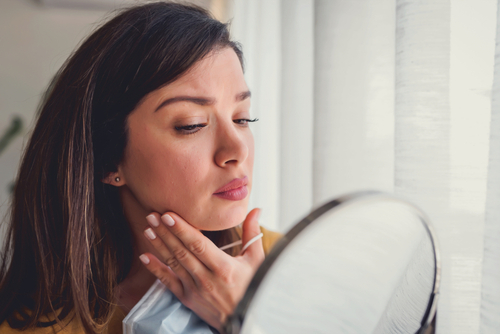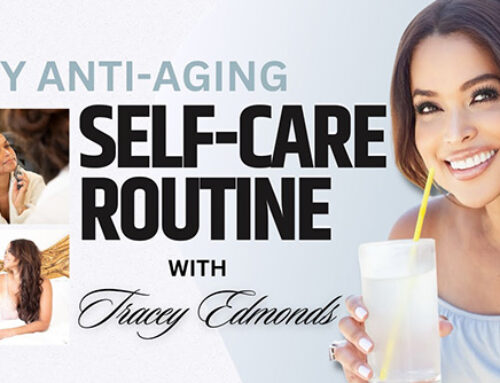The global pandemic has transformed our lives in countless ways. Now when we go out to public spaces or are near someone outside of our household, we are required to wear a mask to stop the spread of COVID-19. [1] Scientific research has proven that masks are a pretty effective form of protection. [2] But masks do come with a downside — maskne. [3] What is maskne? Across the media, it’s the term used for acne that stems from frequently wearing a mask. If you’re worried about getting it or currently have an outbreak and don’t know what to do, check out this guide.
No Need to Worry — Maskne Is A Totally Normal Bodily Reaction to Wearing A Mask
Let’s face it: though it’s great for public health, wearing a mask can feel a bit unpleasant at times. One of the reasons why is because masks create a really humid environment on your face. [4] In addition to being uncomfortable, this can increase the amount of bacteria on your skin. Our skin already naturally produces oil and we’re covered in dead skin cells. Masks can increase your levels of oil, bacteria, and dead skin cells and subsequently cause acne outbreaks. So, if you have maskne, don’t freak out — this is a normal bodily reaction and there are ways to mitigate this issue and decrease your chance of getting future outbreaks.
Maskne Can Be Prevented and Treated with Practical Tips
If you’re experiencing maskne or worried about developing an outbreak, take a look at some practical tips on how to prevent it or treat it.
Use Less Makeup
When it comes to wearing makeup and treating maskne, dermatologists generally recommend that you wear less. [5] Since concealer, blush, and foundation can clog pores, it can potentially make a bad problem worse. [6] You don’t have to take a complete break; you can just use a minimal amount of makeup. However, getting makeup stains on your reusable mask can make it unusable so that’s something to also consider. [7]
If You Have Facial Hair, Consider Integrating New Products into Your Skincare Routine
Facial hair can cause more moisture and warm air to get entrapped into your mask. [8] But you don’t have to shave off that beard or mustache. Instead, wash your face with a toner that contains alpha hydroxy acid. After you’re done washing your face, remember to dry it off before putting your mask back on so more moisturizer doesn’t get entrapped. [9]
Wash Your Face Frequently and Moisturize
A great way to tackle your maskne outbreak is to change up your skincare routine. During quarantine, it can be tough to put that extra effort into your hygiene. But it’s totally worth it to prevent maskne and boost your self-confidence. Here’s a step-by-step skincare guide:
Frequently wash your face: Remember to wash your face in the morning and right before you go to sleep. You should also wash your face after a workout that
- made you sweat a lot. Once you have washed your face, always dry off your face with a towel.
- Moisturize: When choosing a moisturize, use a product that is non-comedogenic, meaning products that won’t block your pores and subsequently trigger an acne outbreak. [10] Do you naturally have dry skin? Masks can exacerbate the issue by irritating your skin. So, apply a light layer of moisturizer on your face before you put on your mask.
You May Need to Change Your Mask Routine and the Type You’re Wearing
A maskne outbreak could be a sign that you need to change how you’re wearing a mask and your mask routine. These are a few things to consider:
- Change Your Fabric: Choose a fabric that’s right for you. Lightweight fabrics may feel more breathable and comfortable. However, it’s important to remember that masks are supposed to protect you and others from COVID-19 so you shouldn’t wear a mask that’s too light or flimsy.[11] If your skin is having a negative reaction to a mask, consider using something soft and cotton-based rather than synthetic. [12]
- Wash Your Masks: Reusable masks can be a good economic option, but you should wash them every day, so they don’t accumulate bacteria.
- Take Breaks: According to the American Academy of Dermatology Association, you can feel free to remove your mask for fifteen-minute increments every four hours. [13] You should also take off your mask when you’re alone, outside by yourself, or not near anyone who isn’t in your household. By taking breaks, you can reduce your chance of getting maskne. Another plus side — less mask fatigue.
- Bring an Extra Mask with You: Carry an extra mask just in case you get dirty. This way, you won’t be walking around with a mask that has a lot of bacteria.
Even if you implement all the right tips, you may still experience an acne outbreak. Though this can be frustrating, you shouldn’t give up. You may need to invest in the right products. There’s a wide range of products out there. A common acne treatment prescription is retinoids such as tretinoin[14] in a topical cream. Tretinoin has been proven to be effective at reducing outbreaks. You should also look into cleansers and specialized moisturizers. Another useful product is benzoyl peroxide which can help your acne by drying it out and killing excess bacteria. [15] If you’re struggling to find a skincare routine that works for you, book an appointment with a dermatologist to see what they recommend.
Embrace A Healthier Lifestyle
A maskne outbreak can also be a sign that you need to change other factors of your lifestyle. Studies have shown that there’s in fact, a relationship between your diet and acne. [16] To prevent future outbreaks, eat a healthy diet consisting of vegetables and fruit. [17] Consume proteins that are high in omega-3 fatty acids such as fish and other sorts of seafood. [18]
Since masks are going to be part of our daily lives for a while, it’s worth investing in the right products and routines to mitigate maskne. If you experience an outbreak, don’t feel defeated. With these tips, you can stay on top of your skin health while also continuing to do your part to stop the spread of COVID-19.
References:
[1] https://www.cdc.gov/coronavirus/2019-ncov/prevent-getting-sick/about-face-coverings.html
[2] https://www.medicalnewstoday.com/articles/what-is-the-protective-value-of-different-face-masks
[3] https://www.nytimes.com/article/maskne-acne.html
[4] https://www.healthline.com/health/maskne#causes
[5] https://www.cnn.com/2020/08/06/cnn-underscored/maskne-treatment-prevention
[6] https://www.healthline.com/health/maskne#prevention-tips
[7] https://health.clevelandclinic.org/the-struggle-with-maskne-is-very-real/
[8] https://health.clevelandclinic.org/the-struggle-with-maskne-is-very-real/
[9] https://health.clevelandclinic.org/the-struggle-with-maskne-is-very-real/
[10] https://www.healthline.com/health/beauty-skin-care/non-comedogenic
[11] https://health.clevelandclinic.org/the-struggle-with-maskne-is-very-real/
[12] https://www.healthline.com/health/maskne#bottom-line
[13] https://www.aad.org/public/everyday-care/skin-care-secrets/face/prevent-face-mask-skin-problems
[14] https://www.ncbi.nlm.nih.gov/pmc/articles/PMC5300732/
[15] https://www.healthline.com/health/benzoyl-peroxide-for-acne
[16] https://www.ncbi.nlm.nih.gov/pmc/articles/PMC4884775/
[17] https://www.mayoclinic.org/skin-care/art-20048237/in-depth/art-20048237
[18] https://www.ncbi.nlm.nih.gov/pmc/articles/PMC4884775/





Leave A Comment